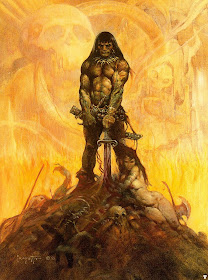When I was about ten, I discovered Robert Ervin Howard's saga of Conan The Barbarian books, written in the 1930s, first published in the 1950s, and really selling well in the late 1960s after they were reprinted with spectacular new cover art by artist Frank Frazetta, perhaps the most sought-after cover artist in history and a cult art figure amongst his millions of followers.
Frazetta's covers set Howard's grim sword & sorcery (a sub-genre that Howard invented) novels on fire. One of those paintings by Frazetta recently sold for one million dollars.

Above is "Conan The Destroyer" which is perhaps Frazetta's iconic image of Howard's brooding hero. A really good analysis of this painting in The Cimmerian can be read here.
Why am I writing about this? Because I've just found out that a new Conan The Barbarian movie (in 3D) is set to be released later this summer. See the trailer below.
As a Conan fan, I'm really looking forward to this film, but I already have a complaint. In the Conan saga, Howard goes to extreme details in describing the savage hero of the series, but it was the Frazetta book covers which burned the Conan image into the minds of its readers, and in this new film, this Conan (portrayed by actor Jason Momoa) is missing the barbarian's most prominent feature: bangs.
This film's directors should have done their homework, as Conan fans, who otherwise loved the 1980s Conan movies starring Arnold Schwarzenegger, howled back then because their hero also lacked the iconic bangs of Cimmerian men's hair styles as invented by Frazetta, not Howard (who actually described Conan's hair as “tousled,” “matted” and “lion-like").
So who's right?
"…a man whose broad shoulders and sun-browned skin seemed out of place among those luxuriant surroundings. He seemed more a part of the sun and winds and high places of the outlands. His slightest movement spoke of steel-spring muscles knit to a keen brain with the co-ordination of a born fighting-man. There was nothing deliberate or measured about his actions. Either he was perfectly at rest–still as a bronze statue–or else he was in motion, not with the jerky quickness of over-tense nerves, but with a cat-like speed that blurred the sight which tried to follow him."
– Robert E. Howard, “The Phoenix on the Sword”